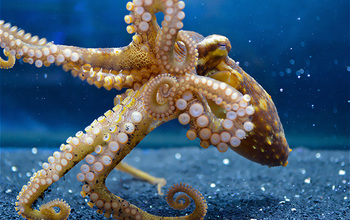Multimedia Gallery
Chemotactile receptors in suckers of octopus help them explore surroundings
Chemotactile receptors in the suckers of octopus allow the animals to methodically explore their surroundings using "taste by touch." Researchers traced the evolutionary adaptations in the sensing capabilities of octopus and squid, revealing evolutionary links to human brain receptors.
[Research supported by U.S. National Science Foundation grant DBI 2010728.]
Learn more in the UC San Diego news story Tracking a New Path to Octopus and Squid Sensing Capabilities. (Date of image: Unknown; date originally posted to NSF Multimedia Gallery: Sept. 22, 2023)
Credit: Anik Grearson and Peter Kilian
Images and other media in the National Science Foundation Multimedia Gallery are available for use in print and electronic material by NSF employees, members of the media, university staff, teachers and the general public. All media in the gallery are intended for personal, educational and nonprofit/non-commercial use only.
Images credited to the National Science Foundation, a federal agency, are in the public domain. The images were created by employees of the United States Government as part of their official duties or prepared by contractors as "works for hire" for NSF. You may freely use NSF-credited images and, at your discretion, credit NSF with a "Courtesy: National Science Foundation" notation.
Additional information about general usage can be found in Conditions.
Also Available:
Download the high-resolution JPG version of the image. (1.3 MB)
Use your mouse to right-click (Mac users may need to Ctrl-click) the link above and choose the option that will save the file or target to your computer.

